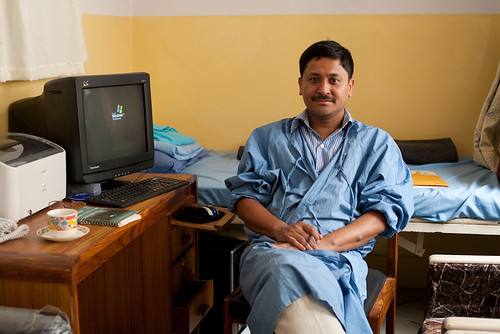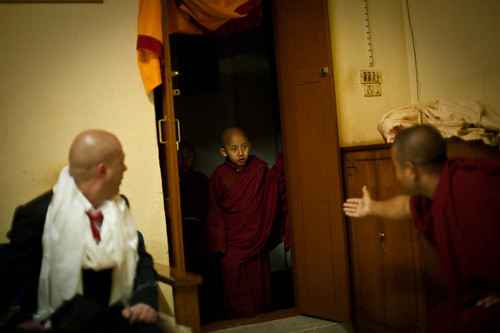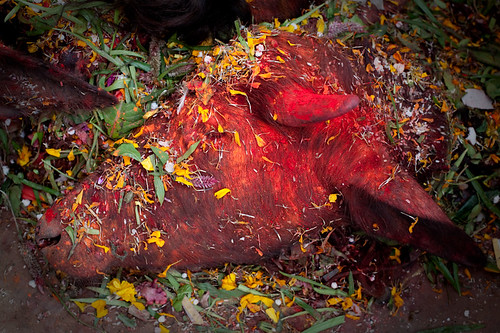Sunday, December 27, 2009
And now the doctors are going on strike...
On December 15th, two men were waiting for him at his gate on returning from work and attacked him with a khukuri knife. Dr Upadhyaya is lucky to have suffered only minor cuts. The men then fled on motorbikes and could not be followed.
Why was he attacked? “That is the main question for me,” he explains, “I have no single enemy after 25 years of practicing medicine. There has been no demand for money. There has not even been a bad conversation on the telephone.”
“Part of our role at NMC is licensing doctors. There are some people who have trained outside Nepal, in Russia, or India who have failed the licensing exam to practice in Nepal. Some have failed so many times, up to 14, 15 times. Our guess is that it might have come from that group – but we really don’t know, we’re just speculating.”
The attack was a trigger for the NMC’s sister organisation, the Nepal Medical Association (NMA), to threaten a one day bandh on 28th December unless their demands were met. The NMA represent the interests of medical professionals in Nepal. The bandh will result in a voluntary stopping of work in all departments except emergency.
Dr Kedar K.C., president of the NMA explained that the primary demand was for measures to increase safety of doctors in the workplace. Apparently there have been up to 40 attacks on doctors in the last 2 years across Nepal. Bundled in with this are a call for increased health budget, increase in the number of doctors, better equipment, abolishing 5% tax on salaries (which is anyway passed on to the consumer) all the way to setting up Bir Hospital as a centre of excellence and the foundation of a new medical university.
This is a worthy list but already the NMA’s strategy has fallen apart before it has started. Firstly it has diluted the issue of violence against doctors with many other complicated issues, including some self-serving ones (tax reductions, increase in private hours allowance). It could be perceived as using the frightening attack on a senior doctor to force through an increase in their benefits.
Secondly it is using the thuggish tactic of the bandh. While this could be justified in extreme cases, and after all other options have been explored, here the NMA is offering the public punishment as a kneejerk reaction to an event of 13 days earlier that additionally didn’t happen in a hospital. In calling a bandh, while not blocking roads, it puts itself in the same camp as all of the other flag-waving, violent, tyre-burning, unwilling-to-negotiate rock-heads.
What does the head of the NMC think about the bandh? “From a personal point of view, and that of registrar, I would not support it, but then I am a victim too. From a medical ethics point of view, I should not support it. It is a very crucial question for me.”
If Dr Upadhyaya has his reservations, it would seem unlikely that the long-suffering public are going to be offering their unswerving support. And there is the third point – never call a strike of a public service unless you have built up firm public support for your case beforehand.
How does Dr Upadhyaya he see the best way to improve the protection for medical staff in Nepal? “It is very difficult question. If the whole country is going in one direction, how can you protect [anything]. We are in the same direction as Afghanistan; there is no law and order here.”
“The home minister said about a year ago ‘I cannot safeguard my own life, how can I safeguard the lives of others?’.”
So then what good is this bandh going to do? Let’s wait and see. Perhaps the government will shrug their shoulders and call their bluff.
The NMA has missed a great opportunity for developing public relations. It could have detailed the terrible cases of violence against doctors, the dedication that medical staff show, the long hours, awful equipment, weak management and the fact that hospital budgets are lower than WHO minimum recommended levels. They could have played on the fact that ministers often use the public purse to get treatment overseas. Or wheeled out some happy, satisfied patients to rally support for doctors. It could have managed the expectations of the public, that doctors always do their best for patients, but that they cannot work miracles and sadly some patients will die.
It could have opened a conversation with the public about why doctors (and society at large) are suffering violence and what should be done. And then, importantly, show that they’re actually listening and thank them for engaging.
Instead, tomorrow, doctors will further loose favour with the public and strengthen the choking culture of the bandh as the only way to fix problems. In many ways, they will have just made the problem worse.
Thursday, December 24, 2009
Smallest buddhist in the house. Seto Gomba, Kathmandu.
I am lucky. I complain about a lot of things, but life for me is interesting and life for me is good. This evening, Christmas eve (although this has little meaning for me), was spent as the fourth attendee of a Buddhist wedding. The other three were the bride, groom and their young daughter.
The wedding took place under the auspices of a particular Ringpoche (name escapes me) in the Seto Gomba, the White Monastery, near Boudha in Kathmandu.
In this picture, the wedding is over and formalities are being completed in the office. Every monk in the house, and all employees too, are receiving a 100 rupee gift from the groom from a rather thick wad of cash managed by Tenzin Chopel (hand outstretched, right).
Here, hesitantly comes the smallest monk of the Gomba into the office to receive his money.
Best viewed large on black, click here
Wednesday, December 23, 2009
Dhaulagiri & top trumps

A photo I once took of Dhaulagiri is now on a German set of top trumps called "Mountains of the World". Mountains get rated on the following: Höhe / Erstbesteigung / Schartenhöhe / Dominanz / Besteigungen / Todesrate = Height / first ascent/height of col / dominance (distance from other comparable mountains I think) / number of ascents / death rate. Something like this anyway.
Finally mountaineers' pub debates over the difficulty of various mountains can now be settled in a civilised card game.
http://www.quertett.de/index-Dateien/page0007.htm
Saturday, December 19, 2009
Die, Nepal Bandh, die
Looking forward to the coming 3-day bandh? Looking forward to the fact that a few big egos with no-one's interests at heart but their own, will oppress you for three long days with the real threat of cheap several-hundred-rupee-per-day-hired-violence. Who benefits from this? Can bullying create lasting change? After 15+ years of bandhs, does it have the power of shock and awe any more? Or is there only the sorry, stale whiff of an unshaven thug's day-old armpit about it. It stinks. It's terrorism on the street corner and the masses lie down and take it as a part of life in Naya Nepal. The more things change, the more they stay the same. But wait a minute....
- Its not my job to stop it
- I am helpless to face up to it myself, what can I do?
and
- So what, its just a few days, I can wait it out
- Uh, what, I'm asleep.... zzzz
Here's a suggestion. Instead of looking for the nuclear bomb that will wipe bandhs from the face of history tomorrow, let's take it slowly, be creative, be surprising, reject the shouting, chest beating old-school ways, and have a lot of sneaky fun. Sounds like an ideal romance, no? Let's start by giving a hint of the steam in this youthful pressure cooker. Start by making small cracks in the wall of nonsense surrounding the rulers of this country, the ruling caste.
START THINKING!
Time to start brainstorming on this wall and discussion forum. There is no hierarchy here. You have a good idea? Share it. You think we're all stupid? Please let us know. Have a terrible idea? Inspire someone else to improve it. Its open to all. Get thinking. Discuss with your friends.
What has come up so far? Only a few can be published (let's be a bit subtle) and there are some good techno-ideas.
- "What about 'Flash Mob'"?, asked a few people - showing the strength of the silent majority without violence. Know what it is? An sms alert brings a huge mass of people together at short notice at a specific location with secret instructions. Then disperse immediately after the action is over.
- "Exposing faces behind the mob", suggested another. Get snapping pictures of bandh enforcers, and start posting pictures on this and other forums. This is one small way of empowering ourselves and see the faces behind this destructive forms of protests.
- Phone jamming - "if you get 1000 people to call every party head office and express their opinion on bandh, would be fun no?"
- Email the editors - "Mass send emails to the editors of the mass media in Nepal. 'Please publish on letters page: Dear Sir/Madam, I am 23 from Lalalalitpur and I want to express my view on the bandh culture which is a hand at the throat of this nation....etc etc'", suggested one of you. "If they don't read or publish every letter, at least they get the message from a constipated in-box."
- "A bandh day football tournament on tundikel, mass random cricket competition in the streets, a cycle rally for the hard-core orwhat the hell - let's just get people, lots of people together. Otherwise its pathetic, isn't it?", brainstormed yet another.
- "Eggs, eggs, eggs - or should it be shoes?", asks a foreigner. "Where is the dissent in this country!?"
We have got some secret underground plans on the way. We are looking for activists like you! Let us know if you want to be a bit more hands-on in removing the culture of bandh from this country. If you feel you want to remain hands-on-keyboard and contribute ideas, please feel free to send us ideas (however simple they might be) in the discussions forum in this group. If you want to do so anonymously, please email us at: zerobandh@gmail.com
Get out, take pictures, listen, look, talk to people about their view of bandh, listen hard, ask them more questions, listen, listen, and report your stories.
"If you think you are too small to make a difference, try sleeping in a room with a mosquito." Some wise person said that. You all know its true.
We'll be in touch soon regarding the above. Be ready to bite.
http://www.facebook.com/group.php?gid=60117778340
Sunday, December 13, 2009
Kathmandu's Bir Hospital celebrates first anniversary of successful kidney transplant.

Dr. Pukar Chandra Shrestha, transplant surgeon, Bir Hospital, Kathmandu, Nepal, originally uploaded by rpb1001.
12 December 2009
Today, the 120 year old Bir hospital in Kathmandu celebrates the anniversary of its first successful kidney transplant.
Bir’s renal transplant department was the brainchild of surgeon Dr. Pukar Shrestha who spent six years training in UK. In his last role he was a senior registrar at the Freeman Hospital in Newcastle before choosing to return to Nepal over promotion to consultant.
“I was thinking, ‘Nepal needs me’,” he recalls. “In the UK there are many like me, but here in Nepal every patient needs doctors like me.”
In the past 12 months 16 patients have been given kidneys donated from family members. “16 is good success over 11 months, however we used to operate on up to 15 patients every week in Newcastle.”
The department’s target is one transplantation per week. But there are major obstacles to achieving this. For instance, the department has no operating theatre. “We have to borrow the theatre from cardiology or neurology and this is a big limitation,” says Shrestha. Additionally there is no facility for tissue cross matching in Nepal and samples need to be sent to India which is both costly and takes 4-6 days. “On the positive side,” adds Dr Shrestha, “we have a really capable and dedicated team here. We’re also lucky to have strong ties with organisations outside Nepal such as Freeman Hospital, Transplant links and Health Exchange Nepal who are helping us with training.”
Previously the only option for those with Chronic Renal Failure (CRF) was to go to India. While there is no official data, it is thought that up to 100 people cross the border every year paying upwards of 8,000 Euro, sometimes purchasing an organ there.
Now Nepali’s have the option of both Bir Hospital and Tribhuvan University Teaching Hospital (TUTH) which had its first transplant success in mid-2008. While the average cost of a transplant in the USA for example is at least US$ 50,000, both hospitals charge less than 3,500 Euro for a transplant using the best available drugs. “I was trained in the UK and want to work in the same way,” says Dr. Shrestha.
Dr Rajani Hada, Associate Professor of Nephrology at Bir is enthusiastic about transplantation. “Over 50% of patients are below 30. With a transplant they can go on to lead normal, productive lives.”
It is estimated that annually 2800 people suffer from CRF in Nepal. Dr Hada believes that while transplants save lives, the most effective way is early screening and thus prevention. “In my ideal world I would screen all children at school. It costs just 25 NRP (23 Euro cents) for a urine test, and we could catch problems early and treat them. We could eventually reduce that number significantly.”
Present at the short ceremony at the hospital is Dinesh Thapa, 22, who was transplanted seven months ago with a kidney donated by his mother. “We have a new life. For us, the transplant is a miracle,” says Dinesh.
The immunosuppressant drugs he takes daily to stop the body rejecting the kidney cost around 150 euro per month, an amount that is equivalent to a good government salary. “We sell our land,” says his mother when asked how they finance this cost. He is studying journalism and in two years hopes to be able to have job and be able to cover this cost himself.
While operations themselves have been very successful, the cost of medication is a major stumbling block. Some organisations such as UNDP are looking into income generation programs to help transplanted patients and their families afford the drugs. Dr Hada called for the government to remove taxes from immunosuppressants and even offer a subsidy to patients.
“We need to do something for these people,” says Shrestha later, “Dinesh is not working, how long can he sustain these costs?”
“We can’t make an emotional bond with patients or we’d end up in a mental hospital,” says Dr Hada. “Making good decisions for all our patients is the best we can do.”
Sunday, December 06, 2009
Kabir project Kathmandu: Mahesh Ram & troupe
 Kabir project Kathmandu: Mahesh Ram & troupe, originally uploaded by rpb1001.
Kabir project Kathmandu: Mahesh Ram & troupe, originally uploaded by rpb1001.Mahesh Ram & troupe (Meghval Folk Music, Rajasthan, India) This was my first introduction to 'Kabir'. I believe Kabir was a 15th century poet in India. From the little that I know of it, his poetry seems to confront religion as external actions, offerings, chantings, temple visiting etc. God is within - something is within at least. Its refreshing to hear and read this after attending last week's ritual sacrifice for a deity. Many folk artists across the Indian subcontinent play this poetry in a mesmerising, rhythmic style. The band above was part of a festival in Kathmandu - the Kabir project which showed four documentaries by the organiser Shabnam Virmani and others. See: kabirproject.org/ and see also www.youtube.com/watch?v=suWaoJOb1ak for Pakistani qawwal style Kabir. Not sure if this is the same track as on the CD I bought. That, by Farridudin Ayaz & Party was certainly some of the extraordinarily tranquillising music I have ever heard.
Wednesday, December 02, 2009
Gadhimai Mela, Nepal
Last week I attended the Gadhimai Mela. Mela means festival in Nepal. For me it was like another world entirely. The Mela has gained some notoriety internationally because of the ritual slaughter that takes place there. Approximately 12,000 male buffaloes are ritually sacrificed there and many thousands more are slaughtered in the 5km zone around Gadhimai's temple.
I am writing up this experience for the interested to read. Is hard to get a flavour of how it was from pictures alone, but then I don't guarantee that the text will make it that much clearer.
Meanwhile, see the photos here. Some are bloody but please put your squeamishness to one side.
http://www.flickr.com/photos/rpb1001/sets/72157622780160303/
There is a great reflective piece on this here: http://sushma.blogspot.com/2009/11/are-we-civilised-yet.html

